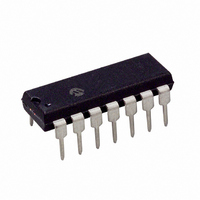PIC16F526-I/P Microchip Technology, PIC16F526-I/P Datasheet - Page 37

PIC16F526-I/P
Manufacturer Part Number
PIC16F526-I/P
Description
IC PIC MCU FLASH 1KX12 14DIP
Manufacturer
Microchip Technology
Series
PIC® 16Fr
Datasheets
1.PIC16F526-ISL.pdf
(122 pages)
2.PIC16F526-ISL.pdf
(22 pages)
3.PIC16F526-IP.pdf
(104 pages)
Specifications of PIC16F526-I/P
Program Memory Type
FLASH
Program Memory Size
1.5KB (1K x 12)
Package / Case
14-DIP (0.300", 7.62mm)
Core Processor
PIC
Core Size
8-Bit
Speed
20MHz
Peripherals
POR, WDT
Number Of I /o
11
Ram Size
67 x 8
Voltage - Supply (vcc/vdd)
2 V ~ 5.5 V
Data Converters
A/D 3x8b
Oscillator Type
Internal
Operating Temperature
-40°C ~ 85°C
Processor Series
PIC16F
Core
PIC
Data Bus Width
8 bit
Data Ram Size
67 B
Maximum Clock Frequency
20 MHz
Number Of Programmable I/os
12
Number Of Timers
1
Maximum Operating Temperature
+ 85 C
Mounting Style
Through Hole
3rd Party Development Tools
52715-96, 52716-328, 52717-734
Development Tools By Supplier
PG164130, DV164035, DV244005, DV164005, PG164120, ICE2000
Minimum Operating Temperature
- 40 C
On-chip Adc
8 bit, 3 Channel
Lead Free Status / RoHS Status
Lead free / RoHS Compliant
For Use With
AC162096 - HEADER MPLAB ICD2 PIC16F526 8/14
Eeprom Size
-
Connectivity
-
Lead Free Status / Rohs Status
Lead free / RoHS Compliant
7.0
The Timer0 module has the following features:
• 8-bit timer/counter register, TMR0
• Readable and writable
• 8-bit software programmable prescaler
• Internal or external clock select:
Figure 7-1 is a simplified block diagram of the Timer0
module.
Timer mode is selected by clearing the T0CS bit of the
OPTION register. In Timer mode, the Timer0 module
will increment every instruction cycle (without pres-
caler). If TMR0 register is written, the increment is
inhibited for the following two cycles (Figure 7-2 and
Figure 7-3). The user can work around this by writing
an adjusted value to the TMR0 register.
FIGURE 7-1:
2010 Microchip Technology Inc.
- Edge select for external clock
Comparator
T0CKI
Output
pin
TIMER0 MODULE AND TMR0
REGISTER
Note 1: Bits T0CS, T0SE, PSA, PS2, PS1 and PS0 are located in the OPTION register.
2: The prescaler is shared with the Watchdog Timer.
3: The C1T0CS bit is in the CM1CON0 register.
C1T0CS
0
1
TIMER0 BLOCK DIAGRAM
(3)
T0SE
F
(1)
OSC
/4
T0CS
0
1
(1)
PS2
Programmable
(1)
Prescaler
, PS1
3
(1)
, PS0
(2)
There are two types of Counter mode. The first Counter
mode uses the T0CKI pin to increment Timer0. It is
selected by setting the T0CS bit of the OPTION regis-
ter, setting the C1T0CS bit of the CM1CON0 register
and setting the C1OUTEN bit of the CM1CON0 regis-
ter. In this mode, Timer0 will increment either on every
rising or falling edge of pin T0CKI. The T0SE bit of the
OPTION register determines the source edge. Clearing
the T0SE bit selects the rising edge. Restrictions on the
external clock input are discussed in detail in
Section 7.1 “Using Timer0 with an External Clock”.
The second Counter mode uses the output of the
comparator to increment Timer0. It can be entered in
two different ways. The first way is selected by setting
the T0CS bit of the OPTION register, and clearing the
C1T0CS bit of the CM1CON0 register (C1OUTEN
[CM1CON0<6>] does not affect this mode of
operation). This enables an internal connection
between the comparator and the Timer0.
The prescaler may be used by either the Timer0
module or the Watchdog Timer, but not both. The
prescaler assignment is controlled in software by the
control bit, PSA of the OPTION register. Clearing the
PSA bit will assign the prescaler to Timer0. The pres-
caler is not readable or writable. When the prescaler is
assigned to the Timer0 module, prescale values of 1:2,
1:4,..., 1:256 are selectable. Section 7.2 “Prescaler”
details the operation of the prescaler.
A summary of registers associated with the Timer0
module is found in Table 7-1.
(1)
PSA
1
0
PS
(1)
OUT
(2 cycle delay)
Sync with
Internal
Clocks
PIC16F526
PS
Sync
OUT
TMR0 Reg
DS41326E-page 37
Data Bus
8














